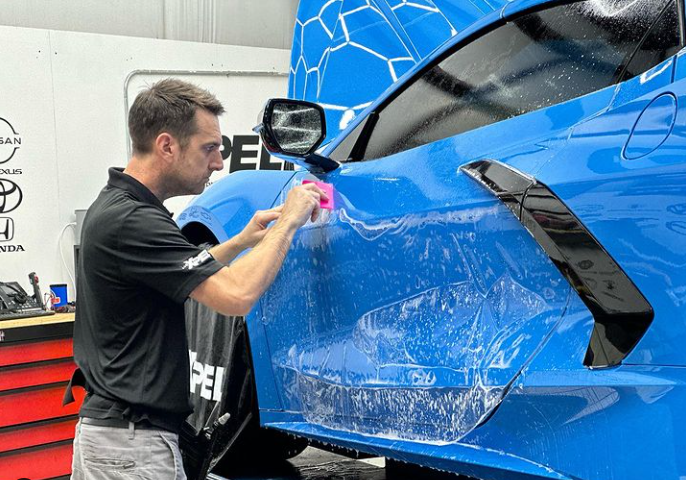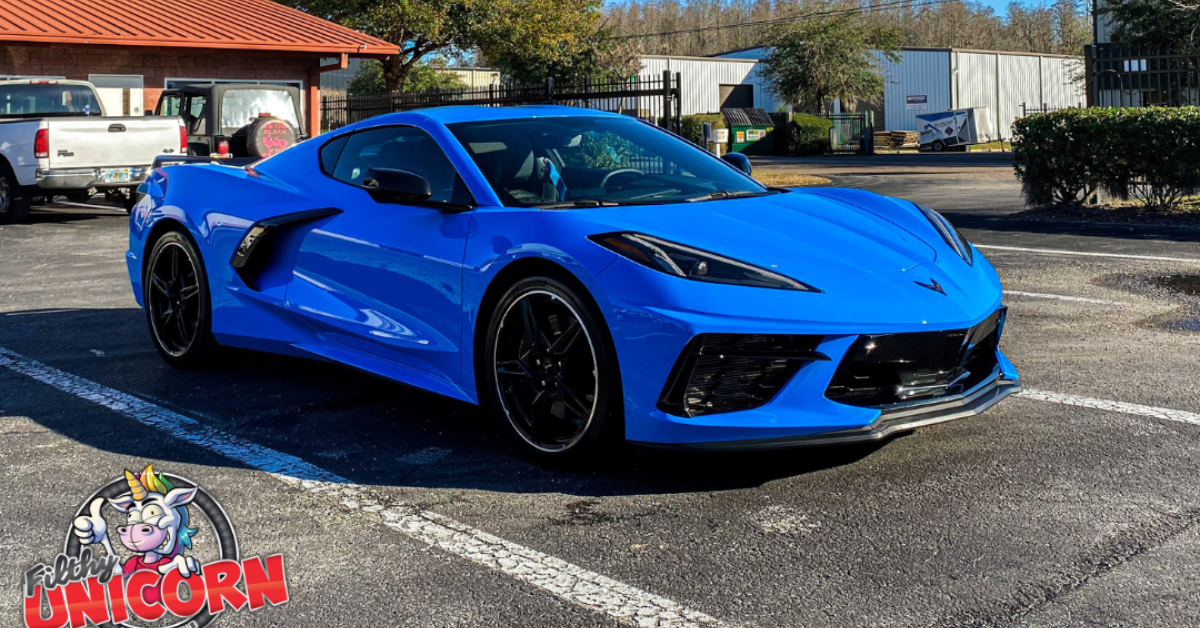Comprehend Paint Protection Film (PPF) – a clear urethane shield for your vehicle’s paint. PPF shields against rock chips, bug splatter, and more. It’s self-healing, erasing minor chips when heated. Professionals use accurate computer-cut patterns for a flawless fit. PPF preserves your car’s appearance and offers protection against road hazards. Safeguard your vehicle’s longevity with PPF.
Key Takeaways
- PPF is a transparent film that shields vehicles from bug splatter, rock chips, and environmental damage.
- It offers self-healing properties, with minor chips disappearing when exposed to heat.
- PPF maintains a vehicle’s appearance, enhances resale value, and reduces maintenance costs.
- Professional installation ensures precise fitting and maximum protection in vulnerable areas.
- Regular maintenance, including washing with pH-neutral soap and inspection for damage, prolongs PPF longevity.
The Basics of PPF
Understanding the fundamental principles of Paint Protection Film (PPF) is essential for vehicle owners looking to preserve their car’s exterior. PPF is a transparent, thermoplastic urethane film applied to the painted surfaces of a vehicle to protect them from rock chips, bug splatter, and other road debris. The film is designed to be self-healing, meaning that minor chips and swirl marks can disappear with exposure to heat, like sunlight or hot water.
PPF is typically applied by professionals using a computer-cut pattern specific to each vehicle’s make and model. The film is carefully placed on the car’s surfaces, ensuring a precise fit that covers vulnerable areas such as the hood, fenders, bumpers, and side mirrors. Once installed, PPF creates a protective barrier that can withstand the rigors of daily driving without altering the appearance of the vehicle.
Vehicle owners often opt for PPF because it offers a layer of defense against environmental hazards while maintaining the car’s original paint finish. This protection is especially valuable for those who want to keep their vehicles looking new and pristine for years to come. By investing in PPF, you can enjoy peace of mind knowing that your car is shielded from the wear and tear of the road, preserving its value and enhancing its longevity.
How PPF Protects Your Vehicle
PPF guarantees your vehicle by forming a durable shield against rock chips, bug splatter, and other external elements that could damage its exterior. This protective film is typically made from thermoplastic urethane, a material known for its exceptional strength and resistance to various hazards. When applied to your vehicle’s surface, PPF creates a barrier that absorbs the impact of small road debris, preventing it from leaving permanent marks or rock chips on the paint.
Moreover, PPF offers self-healing properties, meaning that minor chips or swirl marks can vanish with exposure to heat or sunlight. This feature ensures that your vehicle maintains a pristine appearance for longer periods, enhancing its overall aesthetic appeal. Additionally, the film acts as a shield against bug splatter, bird droppings, tree sap, and other corrosive substances, preventing them from etching into the paint and causing lasting damage. By safeguarding your vehicle’s exterior, PPF helps preserve its resale value and keeps it looking new for years to come.
In essence, PPF serves as an invisible armor for your vehicle, protecting it from the wear and tear of daily driving while maintaining its original finish. With this advanced level of protection, you can enjoy peace of mind knowing that your vehicle is shielded from external elements that could otherwise diminish its appearance and value.
Benefits of PPF Installation
When contemplating PPF installation on your vehicle, you can expect a variety of benefits that surpass mere protection against external elements. Paint Protection Film (PPF) acts as a shield, safeguarding your vehicle’s paint from bug splatter, rock chips, bird droppings, and other environmental hazards that can degrade its appearance. Not only does PPF provide a barrier against physical damage, but it also offers UV resistance, preventing the sun’s rays from causing paint fading or discoloration over time.
Furthermore, PPF enhances the resale value of your vehicle by preserving the pristine condition of its paint. Potential buyers will appreciate the well-maintained exterior, leading to a higher resale price and increased desirability in the market. Additionally, the self-repairing properties of some PPF products ensure that minor chips or swirl marks disappear with exposure to heat, keeping your vehicle looking flawless with minimal maintenance.
In addition, PPF is a cost-effective solution in the long run. By investing in PPF installation, you reduce the need for frequent paint touch-ups or repainting, saving you money on cosmetic repairs. The durability of PPF ensures that your vehicle remains protected for years, giving you peace of mind and a sense of pride in your well-maintained ride.
PPF Application Process Explained
To properly apply Paint Protection Film (PPF) to a vehicle, a meticulous process involving thorough surface preparation and precise installation techniques is crucial. The first step is to clean the vehicle’s surface extensively to eliminate any dirt, debris, or wax that could interfere with the PPF’s adhesion. After cleaning, the surface is carefully inspected for any imperfections that need to be addressed before proceeding.
Next, precise measurements are taken to guarantee the PPF fits the vehicle’s specific contours perfectly. The film is then carefully cut to size using specialized tools and techniques to avoid any gaps or overlaps. This step requires expertise to ensure a seamless and professional finish.
Once the PPF is cut, it’s carefully applied to the vehicle’s surface using a solution to prevent premature adhesion, allowing for proper alignment. The film is then meticulously smoothed out to remove any air bubbles or imperfections that may affect its appearance and performance.
After the PPF is applied, it’s essential to let it cure properly to guarantee maximum adhesion and protection. This process may involve using heat guns or infrared lamps to help the film set correctly.
Maintaining PPF for Longevity
For peak longevity of the Paint Protection Film (PPF) on your vehicle, proper care and maintenance are essential. To guarantee your PPF continues to provide top-notch protection, follow these maintenance tips.
Regularly washing your vehicle is vital to prevent contaminants from adhering to the film. Use a pH-neutral car wash soap and a soft microfiber cloth to clean the PPF surface gently. Avoid using harsh chemicals, abrasive cleaners, or stiff brushes that could damage the film.
Inspect your PPF frequently for any signs of damage, such as peeling, lifting, or discoloration. Address any issues promptly to prevent moisture or debris from getting underneath the film and causing further damage. Applying a ceramic coating specifically designed for PPF can help prolong its lifespan by enhancing its durability and providing additional UV protection.
Avoid parking your vehicle under trees or in areas where bird droppings, sap, or other environmental contaminants may come into contact with the PPF. If your vehicle sustains any damage, such as bug splatter or chips on the film, consult a professional PPF installer for repair options.
Following these maintenance practices will help ensure that your PPF remains in top condition, preserving the appearance of your vehicle and maximizing the longevity of the protective film.
Recap
Think of Paint Protection Film (PPF) as the armor that shields your vehicle from the harsh elements of the road.
Just like a knight’s armor protects them in battle, PPF defends your car’s paint from bug splatter, chips, and other damage.
With PPF, your vehicle is like a fortress on wheels, ready to face the challenges of the open road without fear of damage to its exterior.
At Filthy Unicorn, we are dedicated professionals in the Auto Detailing industry, providing reliable and expert services across Tampa, St. Petersburg, and Clearwater.





